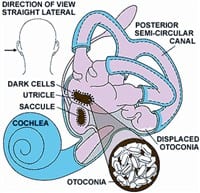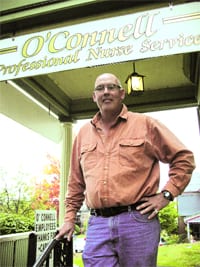Spinning Out Of Control Simple Treatment Resolves Life-altering Condition For HealthSouth Patient
Before her feet even touched the floor, Barbara Rivette knew she was in trouble. Somehow, overnight, her bed had become a merry-go-round that would not stop.
As her mattress spun round and round, Rivette gripped the bed sheets, praying that the movement would cease. It did not. In fact, over the next few weeks, whenever the 66-year-old Ludlow woman would lay down, stand up, or bend over, her world would spin.
“When I rolled over in bed, got up in the morning, or even stood to answer the phone, I was overcome with dizziness,” Rivette said. Sometimes it was accompanied by waves of nausea that forced her to leave work in the middle of the day.
What she didn’t realize was that she was suffering from benign paroxysmal positional vertigo (BPPV), an inner-ear disorder that causes sudden episodes of dizziness produced by a change in head position.
“I lost weight. I couldn’t rest. I was tense all the time just anticipating the dizziness,” Rivette said. “For eight months, my life was a mess.”
Dazed and Confused
Rivette’s search for a way off of her spin cycle led to long series of doctor visits, medical tests, and false diagnoses.
“I had an MRI and a CAT scan,” she said. “One doctor said I had an ear disorder that could lead to declined hearing. I was prescribed medication, which made me sleepy, but I couldn’t lay down.”
Eventually, Rivette’s search brought her to HealthSouth Rehabilitation Hospital in Ludlow. “When my doctor referred me to physical therapy, I didn’t think it would work, but I was ready to try anything,” she said.
At HealthSouth, a physical therapist asked Rivette a series of questions about her dizziness. She was then required to lie down, roll onto her side, and stand. At the end of the evaluation, Rivette was diagnosed with BPPV — the most common cause of dizziness among adults, but a condition that is frequently misdiagnosed.
The disorder is typically caused by otoconia — small crystals of calcium carbonate, sometimes referred to as ‘ear rocks,’ that collect within the utricle of the inner ear when it is damaged by infection, injury, or aging.
“BPPV becomes much more common with advancing age,” writes Dr. Timothy C. Hain, professor of Neurology, Otolaryngology, and Physical Therapy/Human Movement Science at Northwestern University Medical School in Chicago. “In half of all cases, BPPV is called ‘idiopathic,’ which means it occurs for no known reason.”
Occasionally BPPV follows surgery, he adds, where the cause is typically a combination of a prolonged period of supine positioning, or ear trauma when the surgery is to the inner ear.
“Activities which bring on symptoms will vary among persons, but symptoms are almost always precipitated by a change of position of the head with respect to gravity,” Hain notes. “Getting out of bed or rolling over in bed are common problem motions. Women with BPPV may find that the use of shampoo bowls in beauty parlors brings on symptoms. An intermittent pattern is common. BPPV may be present for a few weeks, then stop, then come back again.”
Slowing Down
To resolve BPPV, the ‘rocks’ must be moved out of the sensitive part of the ear into a less-sensitive location. This is accomplished through a series of sequential maneuvers in which the head is moved into four different positions.
Following treatment, which takes only an hour at HealthSouth, patients must refrain from lying flat or on their side for 48 hours. Treatment is successful in about 80{06cf2b9696b159f874511d23dbc893eb1ac83014175ed30550cfff22781411e5} of people diagnosed with BPPV, just one of several types of vertigo.
“It has to be that particular diagnosis for treatment to work. Therefore, the evaluation is the determining factor in how treatment is done,” explained Michelle Downs, a HealthSouth physical therapist.
For Barbara Rivette, the diagnosis was correct, and the therapy worked.
“When I returned to HealthSouth three days after treatment and the therapist asked me to lay down, I got very nervous anticipating the return of my dizziness,” she said. “But when I stood up, the room did not spin. I was so thrilled, I hugged the therapist and thanked her over and over again.”
Symptom-free for nearly a year, Rivette is back doing all the things she did prior to the onset of her vertigo. “I’m like a new person,” she said. “I have my life back, and the treatment only took a few minutes. I wish I had known about it long ago.”



